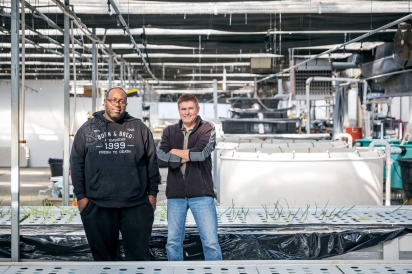Aquaponic Farm Blends Education and Sustainability
In a corner of a greenhouse that was once part of a huge Frank’s Nursery operation in Carleton, tilapia swim quietly in a big round tank. Nearby, green onions grow in water in flat beds topped with Styrofoam sheets. What’s going on here?
You’ve probably heard of hydroponics, growing plants in water. You’ve also likely heard of fish farming, also known as aquaculture. Aquaponics combines the two symbiotically, based on science developed at the University of the Virgin Islands more than 30 years. Still, it remains relatively unknown.
“You can’t go to university or college or even school right now and learn about aquaponics,” says Ken Chio, co-owner and CFO of Aqua Growers of Michigan. He and founder Jim Gill started the company with a mission of feeding people, and teaching them how to feed themselves. “Our humanitarian mission is to make this technology easily accessible to individual families or communities worldwide to empower them to feed themselves and others at a grass roots level,” the mission statement reads.
In addition to raising fish and food, Aqua Growers offers training, consulting, design, installation and sales. “We try to be an A-through-Z aquaponics facility,” Chio says. In four-and-a-half years in business, they’ve worked with schools, urban farms and individuals who want to learn how to get into aquaponics.
So how does it work? A series of tanks, each a bit lower than the one before it, hold fish. Water is pumped up to the highest tank. Gravity feeds it down to the lower tanks, where the fish are kept and fed. Then a separator removes the solids (fish waste) and a bubbler removes gases from the water. The solids go onto the compost pile. The remaining water feeds down to the plant beds.
“What comes into the grow beds is the ammonia from the fish,” Chio says. With the help of microbe inoculation, this turns into nitrates, which the plants utilize as food. Thus cleaned of ammonia, the water recirculates back up to the top.
“If you don’t understand the science and math behind it, you won’t succeed,” Chio says. But once it’s up and running and carefully monitored,
"Your harvest times are shorter because this is such a nutrient rich system; the plants are getting all they need around the clock.” No pesticides or chemicals are used, so the system is “inherently organic.”
The plants are started from seed in coconut fiber, then transplanted into the grow beds, where the Styrofoam sheets keep down evaporation. “The advantage to this is we can grow more per square foot than in soil,” Chio says. “Any nutrient you put into the system will stay put.”
Last summer Aqua Growers grew herbs, lettuce, Swiss chard, tomatoes, Chinese cabbage, Chinese celery and peppers. They sold their produce at farmers’ markets and schools. They’ve also sold fish and expect to do so again in the future.
But in addition to providing food for market, Aqua Growers is involved in training others to do the same. “To me the education is just as important as the product itself,” Chio says. “We’ve kind of done trial and error, so we like to teach people on the mistakes we’ve made.”
In 2016, Aqua Growers installed a small aquaponic system featuring goldfish at The Greening of Detroit’s market garden next to Eastern Market. Romondo Woods, senior farm coordinator at The Greening, said the idea was to put in a basic system so community members could learn how to operate it themselves.
“We want to do more aquaponics because we are all about sustainability,” he says. Though he had a little bit of experience with fish when the system was installed last spring, he acknowledges he’s had a lot to learn. Some of the fish died. “So it’s really like a test trial, because we didn’t know how the fish would react. It’s figuring out how to make the fish comfortable and the people comfortable.”
“The longer you have an aquaponic system operating, the better off you are,” says Edwin Dowell, president of Hanging Roots Farm, who is consulting with The Greening on its installation. Dowell spent some time at D-town Farm and was trained in aquaponics by Aqua Growers. He sees a big future for aquaponics in Detroit, as a way to produce food and clean up water sources such as the Rouge River.
“It’s a game-changer,” he says. “We’re the only ones doing everything around here.”
With higher yields and more nutritious products, “We believe aquaponics is probably the best system,” he says. “I guess you could call it agro-ecology. We wanted to be able to change the world in a small way; better food, better access to food. You can build these in the market where you’re at, you can get to know your grower. That’s where food is going, to a local hub.”
Find out more at Aqua Growers of Michigan







